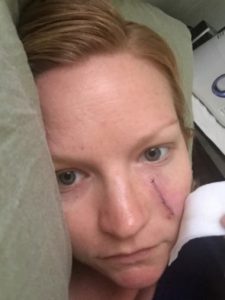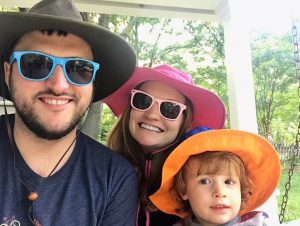Live and Learn: How Skin Cancer Made Prevention a Priority for Me
Ginny Kincaid, MPH
CDC Health Communication Specialist

A few weeks before my son was born I was checking some final things off the list. One of the items included a skin check at the dermatologist. It was there that the doctor said I should have a spot on my face biopsied. The spot turned out to be skin cancer that would require a procedure that ultimately left me with more than 20 stitches in my face.
I felt many emotions. I was stressed about the logistics of getting this done before my son was born; I was scared of what future dermatologist visits would have in store; I felt judged for being by far the youngest person in the surgeon’s office—but mostly the vain part of me hated that I would likely have a scar on my face for the rest of my life. And unfortunately almost exactly a year later, the doctor discovered another skin cancer on my face, requiring another procedure. At least this time I knew what to expect.
Even though I knew I had almost every risk factor for skin cancer,—a lighter natural skin color, red hair, and a lot of sun exposure from my teen years as a lifeguard—I fell into the far too common trap of thinking that skin cancer wouldn’t happen to me. But we know that skin cancer is the most common type of cancer in the U.S. and it can be costly, disfiguring, and even deadly. The good news is that it’s largely preventable.
Through the procedures, stitches, and healing, I like to think my experience serves a greater purpose. In the weeks after my procedure, many people close to me went to the doctor after putting off having unusual spots looked at. My friends who love laying out and getting tan were able to see firsthand the potential consequences of that, and come to the realization that a tan isn’t worth it. My life has changed since the procedures too.
- I now make sun protection a part of my daily routine.

Ginny and her family practicing sun safety. Gone are the days where I only think about protecting my skin at the beach or pool. I wake up, brush my teeth, and put sunscreen on. I also leave extra supplies like sunscreen, sunglasses, and hats in various places I may find myself needing it—in my workbag, my car, and the running stroller. After skin cancer, I realized how much of my daily life takes place outside, running, walking the dog, and going to the park. Instead of sacrificing these healthy activities, I just make sure I’m prepared with sunscreen and a hat, and I try to plan outdoor activities for the morning or late afternoon when UV rays aren’t as strong.
- I embrace my fair skin and the sun-safety look. It may not feel very “cool” to wear a wide-brimmed hat and a rash guard, or long-sleeved shirt, but it’s empowering to set an example for my friends and family. Some of my loved ones have even embraced the sun-safety look with me.
- It has reinforced the idea that prevention can go a long way. No one is immune from habits and decisions from our younger days—even people that work in public health! But it’s never too late to practice good health habits, including protecting our skin from the sun.
 I’d like to encourage everyone to make sun safety a part of your everyday life, regardless of your age, whether you burn or tan, where you live, or what time of year it is. This summer and all year long, I invite you to embrace the skin you’re in, practice sun safety each day, and show us your #SunSafeSelfie!
I’d like to encourage everyone to make sun safety a part of your everyday life, regardless of your age, whether you burn or tan, where you live, or what time of year it is. This summer and all year long, I invite you to embrace the skin you’re in, practice sun safety each day, and show us your #SunSafeSelfie!

